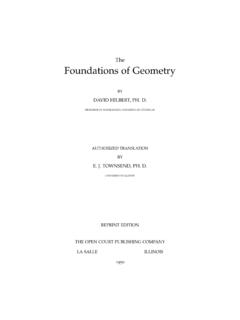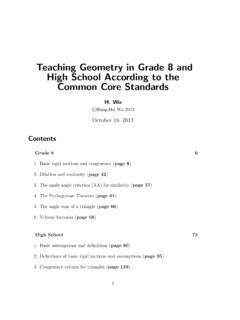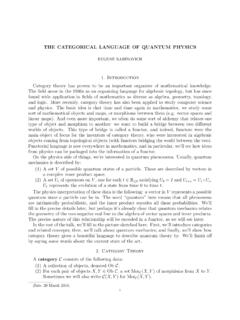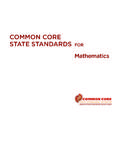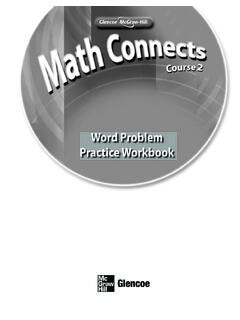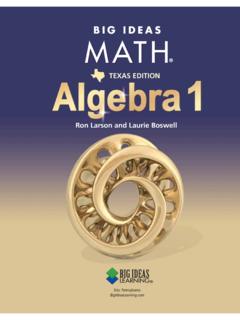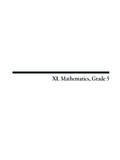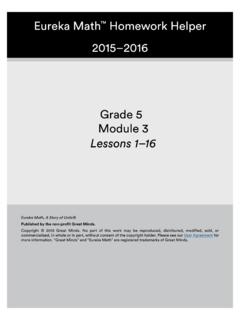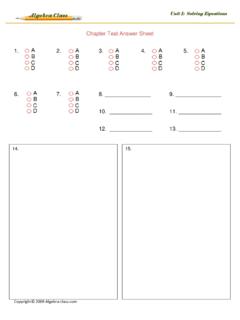Transcription of Homework from Section 4.5 4.5.3. - UCB Mathematics
1 Homework from Section two positive numbers whose product is 100 and whose sum is a wantxandyso thatxy=100 andS=x+yis minimized. Sincexy=100,x6= we havey=100/x, so we want to minimizeS(x)=x+100/x. We find thatS (x)=1 100/x2. SettingS (x)=0 and solving forxyieldsx= 10. Since we arelooking for positive numbers, we takex=10. Notice that for 0<x<10,x2<100, so100/x2>1, which implies that 1 100/x2<0. ThusS (x)<0 for suchx. Similarly, forx>10,S (x)>0. It follows from the first derivative test thatx=0 is a minimum ofS(x). Thusx=10 andy=100/x=10 is a pair of positive numbers whose product is100 and whose sum is a minimum. the following problem: A farmer with 750 ft of fencing wants to enclosea rectangular area and then divide it into four pens with fencing parallel to one side ofthe rectangle. What is the largest possible total area of the four pens?(a) Draw several diagrams illustrating the situation, some with shallow, wide pens andsome with deep, narrow pens.
2 Find the total areas of these configurations. Does itappear that there is a maximum area? If so, estimate it.(b) Draw a diagram illustrating the general situation. Introduce notation and label thediagram with your symbols.(c) Write an expression for the total area.(d) Use the given information to write an equation that relates the variables.(e) Use part (d) to write the total area as a function of one variable.(f) Finish solving the problem and compare the answer with your estimate in part (a).(a) Here are three diagrams. The area of the one on the left is 12500 ft2, the area of themiddle one is 12500 ft2, and the area of the one on the left is 9000 ft2. It seems that thereis a maximum and I would put it at around 13000 (b) Letxbe one side of the overall pen andythe other. The general situation is(c) The total area isA=xy.(d) The variables are related by 5x+2y=750.(e) Since 5x+2y=750, we havey=375 52x. Thus we can writeA(x)=xy=375x 52x2.
3 (f) We find thatA (x)=375 5x. SettingA (x)=0, we solve to findx=75. Note thatforx<75,A (x)>0 and forx>75,A (x)<0. Thusx=75 is a maximum ofAby thefirst derivative test. Furthermore,A(75)= ft2, which is larger than my estimatein part (a). (a) Show that of all rectangles with a given area, the one with smallest perimeteris a square.(b) Show that of all rectangles with a given perimeter, the one with greatest area is asquare.(a) Letxandybe the sides of the rectangle. We haveA=xy, whereAis want to minimizeP=2x+2y. Sincexy=A, we havey=A/x. Thus we haveP(x)=2x+2A/x. SettingP (x)=0, we have 0=2 2A/x2. Thusx= A. Since sidelengths of rectangles are positive, we havex= A. Note that for 0<x< A,P (x)<0and forx> A,P (x)>0. The argument for this is similar to that in problem Thusx= Ais a minimum ofP. Furthermore, we havey=A/x=A/ A= A=x. Sincex=yin this case, the rectangle with smallest perimeter and areaAis a square.(b) Letxandybe the sides of the rectangle.
4 We haveP=2x+2ywherePis we havey=12P x. We want to maximizeA=xy. Plugging in forywe haveA(x)=P2x (x)=P/2 2x. SettingP (x)=0 and solving forxwe getx=P/4. Note thatfor 0<x<P/4,A (x)>0 and forx>P/4,A (x)<0. Thus, by the first derivative2test,x=P/4 is a maximum. In this case we havey=P/2 x=P/2 P/4=P/4= have that of all rectangles with a given perimeter, the one with greatestarea is a square. the points on the ellipse 4x2+y2=4 that are farthest away from the point(1, 0).We want to maximized= (x 1)2+y2given that 4x2+y2=4. Notice that to have4x2+y2=4, we must have|x| 1. While we could solve forxoryand plug it in, it isbetter not to in this case because we do not want to deal with taking plus or minus squareroots. Rather, notice thatd= (x 1)2+y2= x2 2x+1+y2= 1 2x 3x2+4x2+y2= 1 2x 3x2+4= 5 2x we want to maximized(x)= 5 2x 3x2. Setting the derivative equal to 0 yields0=d (x)= 2 6x2 5 2x yieldsx= 1/3. For 1<x< 1/3, 2 6x>0, sod (x)>0.
5 Similarly,for 1/3<x<1, we haved (x)<0. Thusx= 1/3 is a maximum ofdby the firstderivative test. Solving 4x2+y2=4 fory, we find thaty= 2 1 x2, so atx= 1/3,y= 4 2/3. Thus the two points on the ellipse 4x2+y2=4 that are farthest away fromthe point(1, 0)are( 1/3, 4 2/3)and( 1/3, 4 2/3). the area of the largest rectangle that can be inscribed in the ellipsex2/a2+y2/b2= this case the area of the rectangle isA=4xy, where(x,y)is the coordinate of the cornerin the first quadrant. We may assumea,b>0. Solvingx2/a2+y2/b2=1 fory, we gety= b 1 x2/a2. Sinceylies in the first quadrant we havey=b 1 x2/a2. Thus wehaveA(x)=4bx 1 x2/a2. SettingA (x)=0 we find0=4b 1 x2/a2 4bx2a2 1 x2 bya2 1 x2/a2gives0=4ba2(1 x2/a2) 4bx2=4ba2 8bx2,sox=a/ 2, where again we have chosen the positive value of the square root. Analysislike those in previous problems shows thatAis maximized by this value ofA. Thus themaximum area isA(a/ 2)=2ba. cone shaped drinking cup is made by cutting out a sector of a paper circle ofradiusRand joining the two edges.
6 Find the maximum capacity of such a the radius of the circle at the top of the cone shaped cup. The Pythagoreantheorem tells us that the height of the cone ish= R2 r2. Thus the volume isV(r)= 3r2h= 3r2 R2 the derivative equal to 0 we get0=V (r)=2 r R2 r23 r33 R2 thatr=0 is a solution, but in this caseV(r)=0, which cannot be the maxi-mum (also, 0 is not in the domain ofV ). Solving withr6=0 yields the positive solutionr= 6R/3. Analysis similar to previous problems shows this is a maximum. Thus themaximum capacity isV( 6R/3)=2 R39 3. the equation of the line through(3, 5)that cuts off the least area from thefirst the point slope form , the general equation for the line isy=m(x 3)+5. Ifm 0,this line cuts off no area from the first quadrant, but this is a triviality, so assumem< wexintercept is atx=3 5/mand theyintercept is aty=5 3m. Notice that theline cuts of a triangle with base the distance from the origin to thexintercept and heightthe distance to theyintercept.
7 Thus the area cut off isA(m)=xy/2=(5 3m)(3 5/m)/2=12(30 25/m 9m).SettingA =0, we get 0=25/m2 9. Solving formwe getm= 5/3, where we takethe negative value of the square root since we assumedm<0. The first derivative testshows thismminimizesA, so the equation of the line through(3, 5)that cuts off the leastarea from the first quadrant isy= 53x+10. baseball team plays in a stadium that holds 55000 spectators. With ticketspriced at $10, the average attendance had been 27000. When ticket prices were loweredto $8 the attendance rose to 33000.(a) Find the demand function, assuming that it is linear.(b) How should ticket prices be set to maximize revenue?(a) Letp(x)be the demand function. Then 10=p(27000)and 8=p(33000). Sincepisassumed to be linear, this gives a slope of10 827000 33000= using the point-slope formula we havep(x)= 13000(x 27000)+10= 13000x+19.(b) The revenue isR(x)=xp(x)=19x x2/3000. SettingR (x)=0 gives 0=19 x/1500.
8 Solving forxgivesx=28500. The same analysis as before shows thatxis amaximum. At this value the price isp(28500)= Thus ticket prices should be set at$ 5
